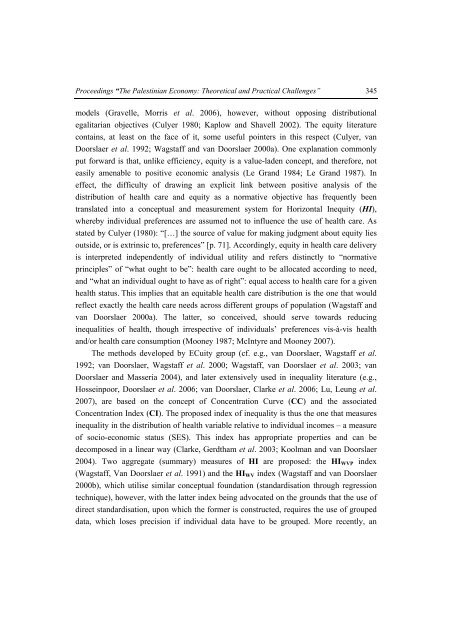The Palestinian Economy. Theoretical and Practical Challenges
The Palestinian Economy. Theoretical and Practical Challenges
The Palestinian Economy. Theoretical and Practical Challenges
You also want an ePaper? Increase the reach of your titles
YUMPU automatically turns print PDFs into web optimized ePapers that Google loves.
Proceedings “<strong>The</strong> <strong>Palestinian</strong> <strong>Economy</strong>: <strong>The</strong>oretical <strong>and</strong> <strong>Practical</strong> <strong>Challenges</strong>” 345<br />
models (Gravelle, Morris et al. 2006), however, without opposing distributional<br />
egalitarian objectives (Culyer 1980; Kaplow <strong>and</strong> Shavell 2002). <strong>The</strong> equity literature<br />
contains, at least on the face of it, some useful pointers in this respect (Culyer, van<br />
Doorslaer et al. 1992; Wagstaff <strong>and</strong> van Doorslaer 2000a). One explanation commonly<br />
put forward is that, unlike efficiency, equity is a value-laden concept, <strong>and</strong> therefore, not<br />
easily amenable to positive economic analysis (Le Gr<strong>and</strong> 1984; Le Gr<strong>and</strong> 1987). In<br />
effect, the difficulty of drawing an explicit link between positive analysis of the<br />
distribution of health care <strong>and</strong> equity as a normative objective has frequently been<br />
translated into a conceptual <strong>and</strong> measurement system for Horizontal Inequity (HI),<br />
whereby individual preferences are assumed not to influence the use of health care. As<br />
stated by Culyer (1980): “[…] the source of value for making judgment about equity lies<br />
outside, or is extrinsic to, preferences” [p. 71]. Accordingly, equity in health care delivery<br />
is interpreted independently of individual utility <strong>and</strong> refers distinctly to “normative<br />
principles” of “what ought to be”: health care ought to be allocated according to need,<br />
<strong>and</strong> “what an individual ought to have as of right”: equal access to health care for a given<br />
health status. This implies that an equitable health care distribution is the one that would<br />
reflect exactly the health care needs across different groups of population (Wagstaff <strong>and</strong><br />
van Doorslaer 2000a). <strong>The</strong> latter, so conceived, should serve towards reducing<br />
inequalities of health, though irrespective of individuals’ preferences vis-à-vis health<br />
<strong>and</strong>/or health care consumption (Mooney 1987; McIntyre <strong>and</strong> Mooney 2007).<br />
<strong>The</strong> methods developed by ECuity group (cf. e.g., van Doorslaer, Wagstaff et al.<br />
1992; van Doorslaer, Wagstaff et al. 2000; Wagstaff, van Doorslaer et al. 2003; van<br />
Doorslaer <strong>and</strong> Masseria 2004), <strong>and</strong> later extensively used in inequality literature (e.g.,<br />
Hosseinpoor, Doorslaer et al. 2006; van Doorslaer, Clarke et al. 2006; Lu, Leung et al.<br />
2007), are based on the concept of Concentration Curve (CC) <strong>and</strong> the associated<br />
Concentration Index (CI). <strong>The</strong> proposed index of inequality is thus the one that measures<br />
inequality in the distribution of health variable relative to individual incomes – a measure<br />
of socio-economic status (SES). This index has appropriate properties <strong>and</strong> can be<br />
decomposed in a linear way (Clarke, Gerdtham et al. 2003; Koolman <strong>and</strong> van Doorslaer<br />
2004). Two aggregate (summary) measures of HI are proposed: the HI WVP index<br />
(Wagstaff, Van Doorslaer et al. 1991) <strong>and</strong> the HI WV index (Wagstaff <strong>and</strong> van Doorslaer<br />
2000b), which utilise similar conceptual foundation (st<strong>and</strong>ardisation through regression<br />
technique), however, with the latter index being advocated on the grounds that the use of<br />
direct st<strong>and</strong>ardisation, upon which the former is constructed, requires the use of grouped<br />
data, which loses precision if individual data have to be grouped. More recently, an
















